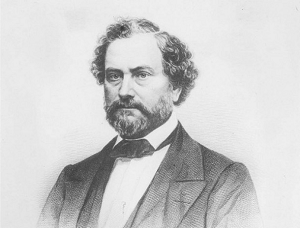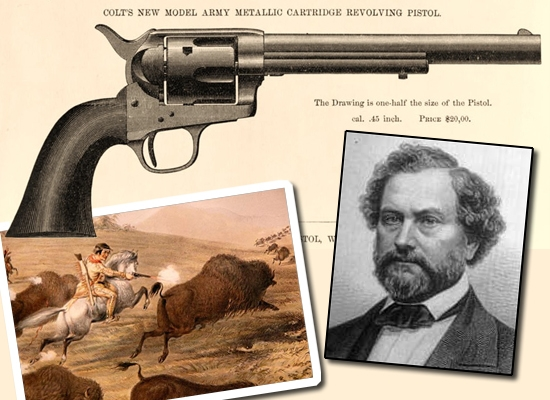


Colt Joins the Craft
 Samuel Colt was born in Hartford, Connecticut, to Christopher and Sarah Colt in 1814. He was one of six children that grew up in a modest home. At age fifteen, Samuel began working at his father’s textile plant and, with a fascination for gunpowder and technology, used the resources at the plant to create his first invention; a galvanic cell (think the early stages of a battery). He took this success and proceeded to display it by attempting to blow up a raft on the Fourth of July. In 1830, he went to work on the sea. It was aboard the brig Corvo that he came up with the idea of the revolver, a firearm that can shoot multiple times without reloading.
Samuel Colt was born in Hartford, Connecticut, to Christopher and Sarah Colt in 1814. He was one of six children that grew up in a modest home. At age fifteen, Samuel began working at his father’s textile plant and, with a fascination for gunpowder and technology, used the resources at the plant to create his first invention; a galvanic cell (think the early stages of a battery). He took this success and proceeded to display it by attempting to blow up a raft on the Fourth of July. In 1830, he went to work on the sea. It was aboard the brig Corvo that he came up with the idea of the revolver, a firearm that can shoot multiple times without reloading.
 The fame of the Colt Revolver grew due to Captain Samuel Walker of the Texas Rangers. After being impressed with the first iteration of the revolver, Walker sought out Colt and purchased one-thousand modified revolvers in 1847. The funding from the Walker Colt pistol allowed Samuel to create the third generation in 1848: the Colt Dragoon Revolver. From that point forward, Colt’s success and fame grew rapidly as testimony after testimony from military officials and civilians alike praised Colt for his efficient firearm that allowed outnumbered combatants a chance against large forces.
The fame of the Colt Revolver grew due to Captain Samuel Walker of the Texas Rangers. After being impressed with the first iteration of the revolver, Walker sought out Colt and purchased one-thousand modified revolvers in 1847. The funding from the Walker Colt pistol allowed Samuel to create the third generation in 1848: the Colt Dragoon Revolver. From that point forward, Colt’s success and fame grew rapidly as testimony after testimony from military officials and civilians alike praised Colt for his efficient firearm that allowed outnumbered combatants a chance against large forces.
 Samuel Colt was born in Hartford, Connecticut, to Christopher and Sarah Colt in 1814. He was one of six children that grew up in a modest home. At age fifteen, Samuel began working at his father’s textile plant and, with a fascination for gunpowder and technology, used the resources at the plant to create his first invention; a galvanic cell (think the early stages of a battery). He took this success and proceeded to display it by attempting to blow up a raft on the Fourth of July. In 1830, he went to work on the sea. It was aboard the brig Corvo that he came up with the idea of the revolver, a firearm that can shoot multiple times without reloading.
Samuel Colt was born in Hartford, Connecticut, to Christopher and Sarah Colt in 1814. He was one of six children that grew up in a modest home. At age fifteen, Samuel began working at his father’s textile plant and, with a fascination for gunpowder and technology, used the resources at the plant to create his first invention; a galvanic cell (think the early stages of a battery). He took this success and proceeded to display it by attempting to blow up a raft on the Fourth of July. In 1830, he went to work on the sea. It was aboard the brig Corvo that he came up with the idea of the revolver, a firearm that can shoot multiple times without reloading.
Once he returned home in 1832, Samuel received financing to produce a rifle and pistol. After funding from his father ended (and a successful rifle), Samuel took to the roads to support his production. Colt told stories to audiences small and large of epic tales revolving around the themes of salvation and redemption. Samuel incorporated fireworks into his shows that captivated crowds across the eastern seaboard. Using the money he earned on the road, Colt employed a Baltimore blacksmith and patented the first revolving firearm in 1836.
The success of Colt’s first generation of revolving guns would not be without hardship. Due to legislation restricting the military from purchasing experimental weapons and the futuristic design, Colt’s firearms failed to reach any kind of critical mass. In 1843, Colt’s manufacturing plant closed and his dream of creating a revolving firearm with easily interchanged parts seemed to slip away.
Samuel Colt was determined to make his dream a success. He stuck to his inventive ways and continued to produce weapons and equipment for the military. Between the success of new musket cartridges encased in tinfoil (as opposed to paper) and waterproof telegraph lines, Colt used his funds to redesign his firearm. This time he focused more heavily on his revolver.
 The fame of the Colt Revolver grew due to Captain Samuel Walker of the Texas Rangers. After being impressed with the first iteration of the revolver, Walker sought out Colt and purchased one-thousand modified revolvers in 1847. The funding from the Walker Colt pistol allowed Samuel to create the third generation in 1848: the Colt Dragoon Revolver. From that point forward, Colt’s success and fame grew rapidly as testimony after testimony from military officials and civilians alike praised Colt for his efficient firearm that allowed outnumbered combatants a chance against large forces.
The fame of the Colt Revolver grew due to Captain Samuel Walker of the Texas Rangers. After being impressed with the first iteration of the revolver, Walker sought out Colt and purchased one-thousand modified revolvers in 1847. The funding from the Walker Colt pistol allowed Samuel to create the third generation in 1848: the Colt Dragoon Revolver. From that point forward, Colt’s success and fame grew rapidly as testimony after testimony from military officials and civilians alike praised Colt for his efficient firearm that allowed outnumbered combatants a chance against large forces.
Colt lived the rest of his life in Hartford married to his wife, Caroline Henshaw, and father of their only child, Caldwell Hart Colt. He joined St. John’s Lodge #4 in Hartford and was raised on March 12, 1851. Samuel Colt died in 1862 of gout. While his life may have only been 47 years long, his fame and impact on the world is still prevalent and shows no sign of diminishing. Firearm enthusiast or not, everyone can appreciate the creative spirit and determination that Samuel Colt had as he revolutionized the world.
webmaster@scottishriteboston.org | All Rights Reserved
The Bodies of the Scottish Rite, sitting in the Valley of Boston, Commonwealth of Massachusetts, acknowledge and yield allegiance to the Supreme Council, 33°, of the Ancient Accepted Scottish Rite of Freemasonry for the Northern Masonic Jurisdiction of the United States of America, whose Grand East is in Lexington, Massachusetts.



